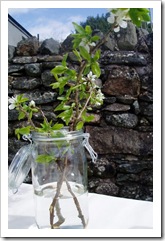We headed out for a stomp around the lake this afternoon, I think we were both in need of stretching our legs after a morning at the computer.

The one find that made my heart leap, was the little red bleaberries forming. They won’t be ripe until July/August, but it’s good to see they are on their way…

Anyway, I digress. Bilberry is apparently too generic. The name I should apparently be using is: bleaberry.
Whatever they are called, they are wonderful to eat and pick either as a refreshing snack while walking, or to pick basketfuls for taking home.












